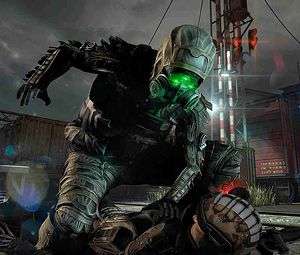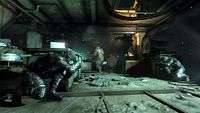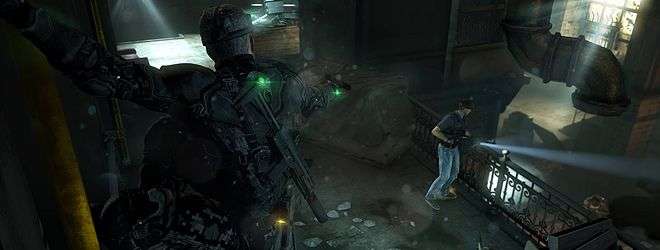Splinter Cell: Blacklist – Review
by Tim
|
 It’s hard to believe that Splinter Cell: Blacklist’s version of Sam Fisher is the same man from previous games. Inexplicably suffering from a curious case of Benjamin Button, you’d be forgiven for thinking that this younger looking and sounding Sam was a different character altogether. Regardless of your levels of experience with Splinter Cell’s past, it’s hard to take a liking to this new Sam. The heavy-handed script and his own lack of gravitas means actor Eric Johnson never shines through the rock and hard place he’s caught between, trying to imitate the old Sam while simultaneously struggling to make his own mark. The result will leave returning players pining for the good old days when the gravelly tones of Michael Ironside spurted from Fisher’s mouth, and new players befuddled as to how this generic spy man is considered a legendary icon within the Clancy-verse.
It’s hard to believe that Splinter Cell: Blacklist’s version of Sam Fisher is the same man from previous games. Inexplicably suffering from a curious case of Benjamin Button, you’d be forgiven for thinking that this younger looking and sounding Sam was a different character altogether. Regardless of your levels of experience with Splinter Cell’s past, it’s hard to take a liking to this new Sam. The heavy-handed script and his own lack of gravitas means actor Eric Johnson never shines through the rock and hard place he’s caught between, trying to imitate the old Sam while simultaneously struggling to make his own mark. The result will leave returning players pining for the good old days when the gravelly tones of Michael Ironside spurted from Fisher’s mouth, and new players befuddled as to how this generic spy man is considered a legendary icon within the Clancy-verse.
Not meaning to sound like a childish gamer who’s up in arms at the recasting of a famous gaming character (there are worse people than Kiefer Sutherland to take over as Snake in Metal Gear Solid V, you know) but the outcry surrounding Splinter Cell’s switcheroo is perhaps more understandable because it makes the least sense. From beginning to end you’ll remain unconvinced that this specific actor in his thirties can play this specific character in his fifties, and, even though you wouldn’t normally care about the acting side of things in a Clancy game, it does begin to detract, especially if you’re a Splinter Cell veteran. Surely, with Michael Ironside unable to reprise his role, the logical solution for Ubisoft Toronto would be for old man Fisher to bow out after his long years of tenure and let someone else don the trifocal goggles instead?
On second thoughts, judging by the blandness of new guy Isaac Briggs, former CIA operative and Sam’s co-op campaign buddy, maybe Ubisoft were right to drag Sam out of retirement for another round of terrorist-thwarting escapades after all. It says a lot about the quality of the cast when the most noteworthy member is a detainee of the newly-formed Fourth Echelon, someone who players of Splinter Cell: Conviction will instantly recognise.
 The villain of the piece isn’t bad either – a cold and ruthless British baldy (Brits always make good bad guys, right) hell-bent on bringing the United States to its knees with weekly attacks, known as the Blacklist, unless all American troops are brought home. And so, as leader of Fourth Echelon, it’s up to Sam to save the day. It’s typical Clancy fare, made more generic than it actually is by snoresome, exposition-heavy storytelling in pre-mission briefings rife with screen tearing and frame rate dips. Blacklist’s presentation is choppy, to say the least, on all fronts.
The villain of the piece isn’t bad either – a cold and ruthless British baldy (Brits always make good bad guys, right) hell-bent on bringing the United States to its knees with weekly attacks, known as the Blacklist, unless all American troops are brought home. And so, as leader of Fourth Echelon, it’s up to Sam to save the day. It’s typical Clancy fare, made more generic than it actually is by snoresome, exposition-heavy storytelling in pre-mission briefings rife with screen tearing and frame rate dips. Blacklist’s presentation is choppy, to say the least, on all fronts.
First impressions aren’t improved much in the gameplay department either. Options to toy with your prey à la Conviction are disappointingly thin on the ground, thanks to restrictive level design coupled with a lack of gadgets and gizmos forcing your hand. What’s worse is the game’s early predominance of daytime-set missions. These have never been Splinter Cell’s strongest suit; it’s why 2006’s Double Agent is widely considered the worst one. And guess what? They still suck here, even if they are superior to what’s gone before. Splinter Cell’s recent slant towards more aggressive stealth means you can get more of a kick out of clearing a sun-soaked area with the snazzy returning Mark and Execute system than plainly hiding out of sight and avoiding detection could, but they still show the game at its worst. There’s potential in relocating some of the series in the sun, but that day isn’t here yet.
 |
 |
 |
 |
 |
 |
But things do gradually get better. Get past the first two to three hours and campaign missions move back into the dark, gadgets become more plentiful through unlocks, and (thank the lord) levels begin to open up, although not quite as much as you’d hope. But most importantly, excluding a handful of ill-judged pre-set moments, you’re free to play however you choose with barely a hindrance to your preferred method of approach.
 Ubisoft are even kind enough to lay out the foundations for the three specific play styles: Ghost (undetected, non-lethal – for the classic Splinter Cell players), Panther (undetected, lethal – for the Splinter Cell: Conviction converts) and Assault (go loud – for people who’ve never played Splinter Cell). Each style is rewarded with funds to further aid your mission, with Ghost awarding most and Assault earning least; a necessary cut to encourage trigger-happy gamers to play Splinter Cell as intended. Blacklist isn’t robust enough in its mechanics, as it thinks it is to be played like a fully-fledged shooter anyhow, so why anyone would want to is a mystery.
Ubisoft are even kind enough to lay out the foundations for the three specific play styles: Ghost (undetected, non-lethal – for the classic Splinter Cell players), Panther (undetected, lethal – for the Splinter Cell: Conviction converts) and Assault (go loud – for people who’ve never played Splinter Cell). Each style is rewarded with funds to further aid your mission, with Ghost awarding most and Assault earning least; a necessary cut to encourage trigger-happy gamers to play Splinter Cell as intended. Blacklist isn’t robust enough in its mechanics, as it thinks it is to be played like a fully-fledged shooter anyhow, so why anyone would want to is a mystery.
Its stealth mechanics, in contrast, are beyond capable and, above all, consistent throughout. Even better, the screen doesn’t turn a colour-sapping monochrome when shrouded in darkness anymore like in Conviction (the lights on Sam’s suit glow brighter when hidden, seemingly invisible to passing enemies – we’ve always let that slide in Splinter Cell). Clearly, it’s the Ghost and Panther play styles you’ll be wanting to stick with; a mix between both offering the most satisfying results.
Leaving guards undisturbed, oblivious to your presence, may cough up the bigger rewards, but sometimes taking that perfect headshot and hiding the body can sometimes be too good an opportunity to pass up. Some irritating instafail sections and the regular overabundance of guards, coupled with some annoyingly-wearing heavy armour and headshot-repelling helmets (don’t even get me started on those, or the dogs), means keeping that no-kill playthrough intact can be tricky at the best of times, although it is always possible providing you’ve chosen the right gear for the right job. Stun darts, noisemakers and sleeping gas are the order of the day here.
 You’re able to kit out your gear on the Paladin, a cargo plane fitted with all sorts of fancy spy equipment and Fourth Echelon’s base of operations. It functions pretty much like Mass Effect’s Normandy – a hub allowing you to chat to your team, activate missions and upgrade your weapons, gadgets and the Paladin itself. Invest some of your earnings on upgrading the cockpit, for example, and a radar will appear on your HUD when on the ground. Spruce up Charlie Cole’s workshop (Fourth Echelon’s equivalent of James Bond’s Q, only more annoying) and he’ll grant you access to some prototype weaponry.
You’re able to kit out your gear on the Paladin, a cargo plane fitted with all sorts of fancy spy equipment and Fourth Echelon’s base of operations. It functions pretty much like Mass Effect’s Normandy – a hub allowing you to chat to your team, activate missions and upgrade your weapons, gadgets and the Paladin itself. Invest some of your earnings on upgrading the cockpit, for example, and a radar will appear on your HUD when on the ground. Spruce up Charlie Cole’s workshop (Fourth Echelon’s equivalent of James Bond’s Q, only more annoying) and he’ll grant you access to some prototype weaponry.
However, the most notable feature of the Paladin is the Strategic Mission Interface. There is no main menu as such in Blacklist. Everything is handled through the SMI: campaign, co-op and Spies Vs Mercs. It’s a well-intentioned and elegant setup, even if lengthy loading times between single and multiplayer portions takes some of the allure away. Still, it serves its purpose in bringing all modes together under one roof. If only said modes were all consistent in quality.
 |
 |
 |
 |
 |
 |
While the single player grows from being not quite the worst to not quite the best of Splinter Cell, the co-op campaign is a big disappointment. Considering Conviction is still home to one of the best dedicated co-op campaigns currently on the market, it’s a shame to see that Blacklist has forgotten what made its predecessor so good. Other than the odd ledge boost and dual breach there’s nothing here to suggest these missions have been designed with two players in mind. They’re not so terrible that you should give them a miss, but, much like the optional Fourth Echelon missions dished out by the different members of Sam’s team, they feel too much like an afterthought, and their tendency to be geared more toward the Assault play style only supports this theory.
Luckily, the asymmetrical Spies Vs Mercs, the number one requested feature from the Splinter Cell community, is ace. It may not be as nerve-shreddingly tense as you remember circa Pandora Tomorrow and Chaos Theory, but this is still a cut above most. As a Spy, played in third person, it’s your job to hack the terminals protected by the Mercenaries, played in first person. Spies use darkness and their agility to outsmart and outmanoeuvre the Mercs who utilise heavy weaponry and brute force to stop the Spies in their tracks. It’s brilliant stuff, and rounds off a sizable if inconsistent package that fails to fully recapture the glory days of Splinter Cell but still just about manages to warrant a recommendation to long-term fans. Everyone else would be advised to check out some of Sam’s back catalogue first.
Pros- Can be played like classic Splinter Cell (Chaos Theory)
- Can be played like new Splinter Cell (Conviction)
- The SMI blurs all modes together smartly
- Spies Vs Mercs is back
- Fourth Echelon need to lighten up
- Co-op campaign dissatisfies
- Screen tearing and frame rate drops
- The sun. It burns!
There’s a lot wrong with Splinter Cell: Blacklist. Its uncharacteristic opening hours remind you of the disappointing Double Agent, while weak storytelling and unlikable characters make it a struggle to keep up with the plot, and the replacement of Michael Ironside as Sam Fisher is regrettable. But keep at it and you’ll find Blacklist is still a true, if not pure or definitive, Splinter Cell experience at its heart. It can still be about playing the waiting game, skulking in the shadows and choosing your moment to slink past or pounce on your prey, and that has always been where Splinter Cell is at its best. Blacklist is no different. It just takes time to get there, so don’t blacklist Clancy’s latest just yet.
Last five articles by Tim
- Future Perfect
- A Thief's Alternative End
- Uncharted 4: A Thief’s End - Review
- Ratchet & Clank - Review
- Gears Of War 4 – Multiplayer Beta Impressions


























There are no comments, yet.
Why don’t you be the first? Come on, you know you want to!